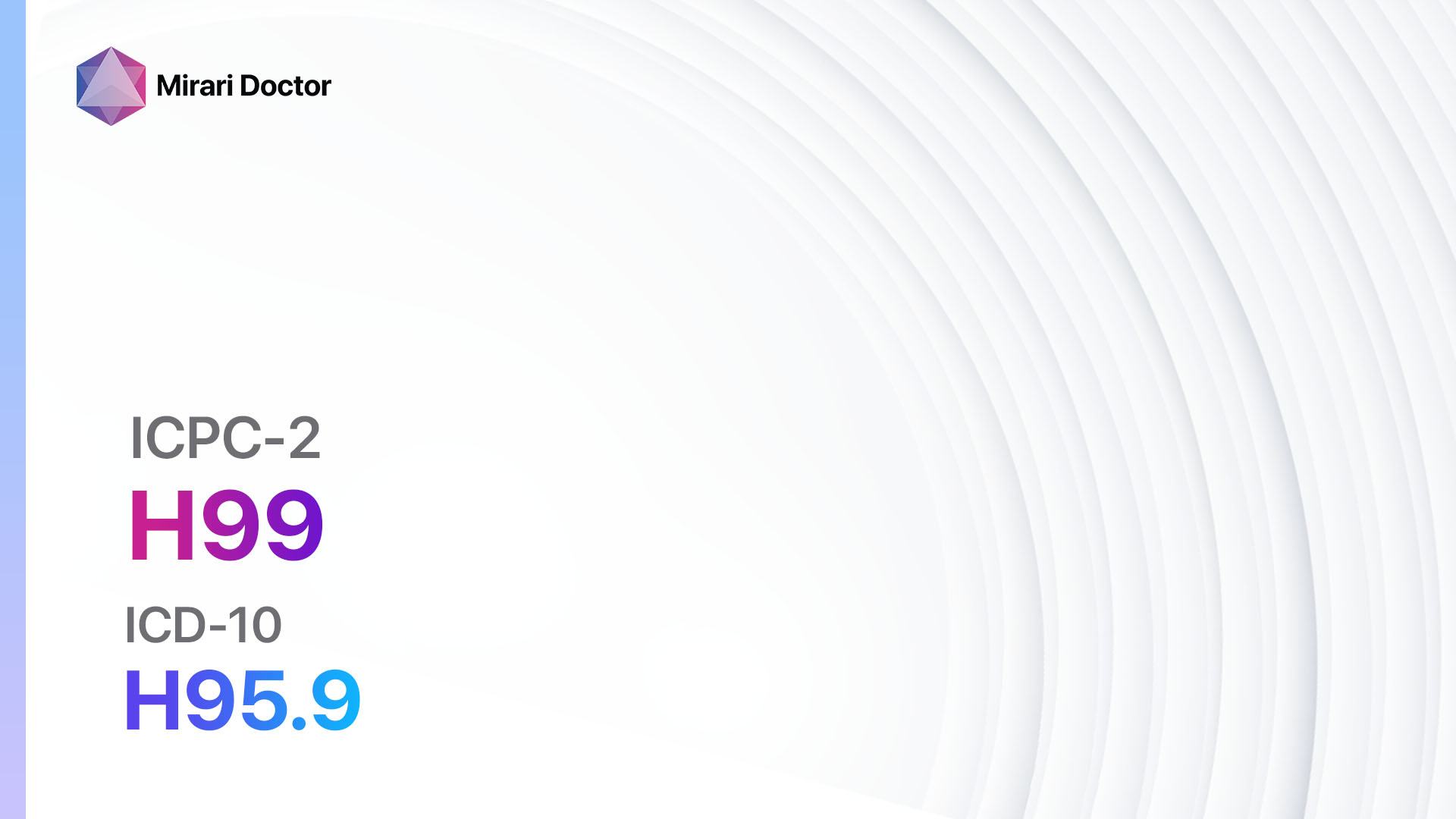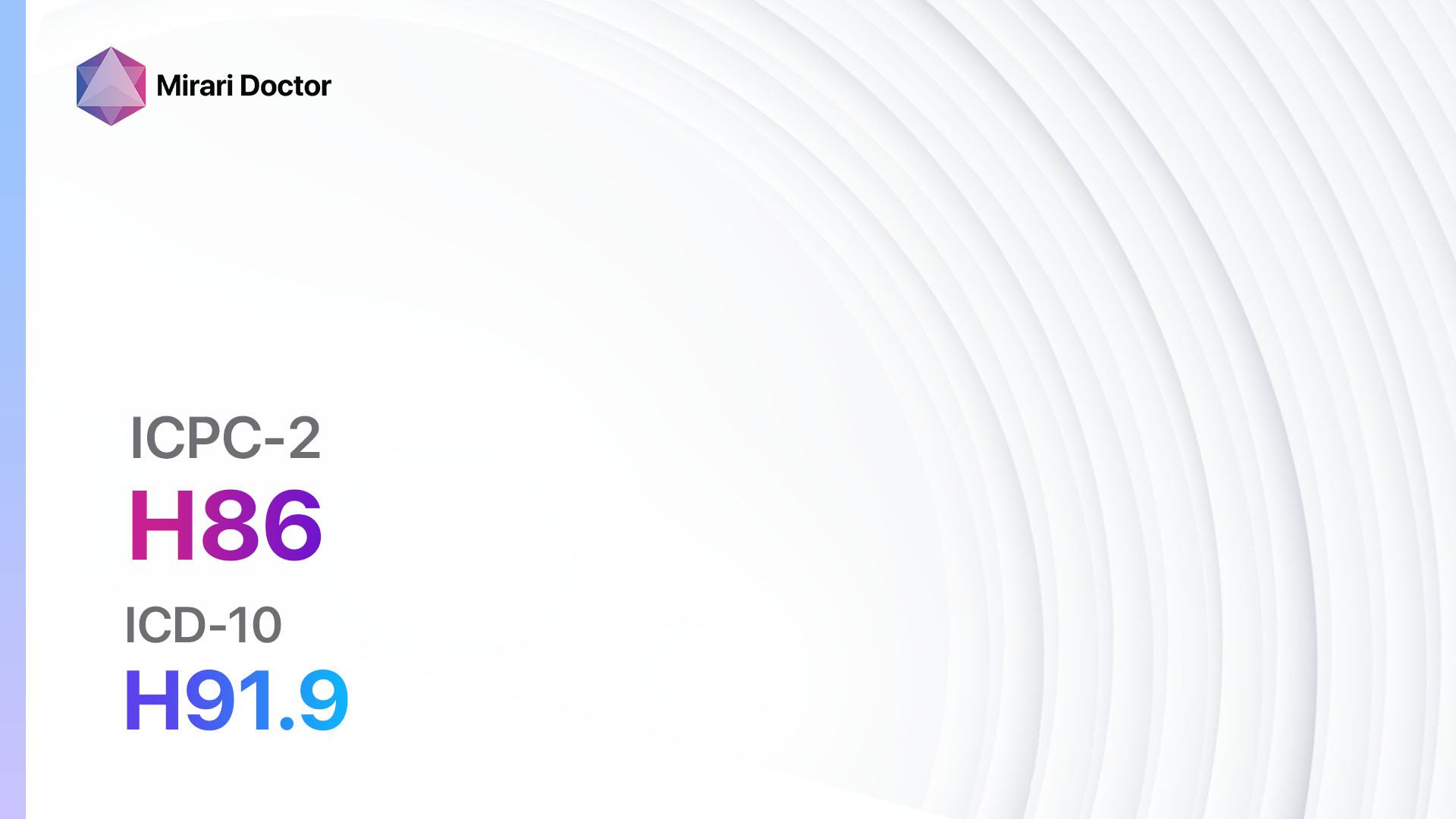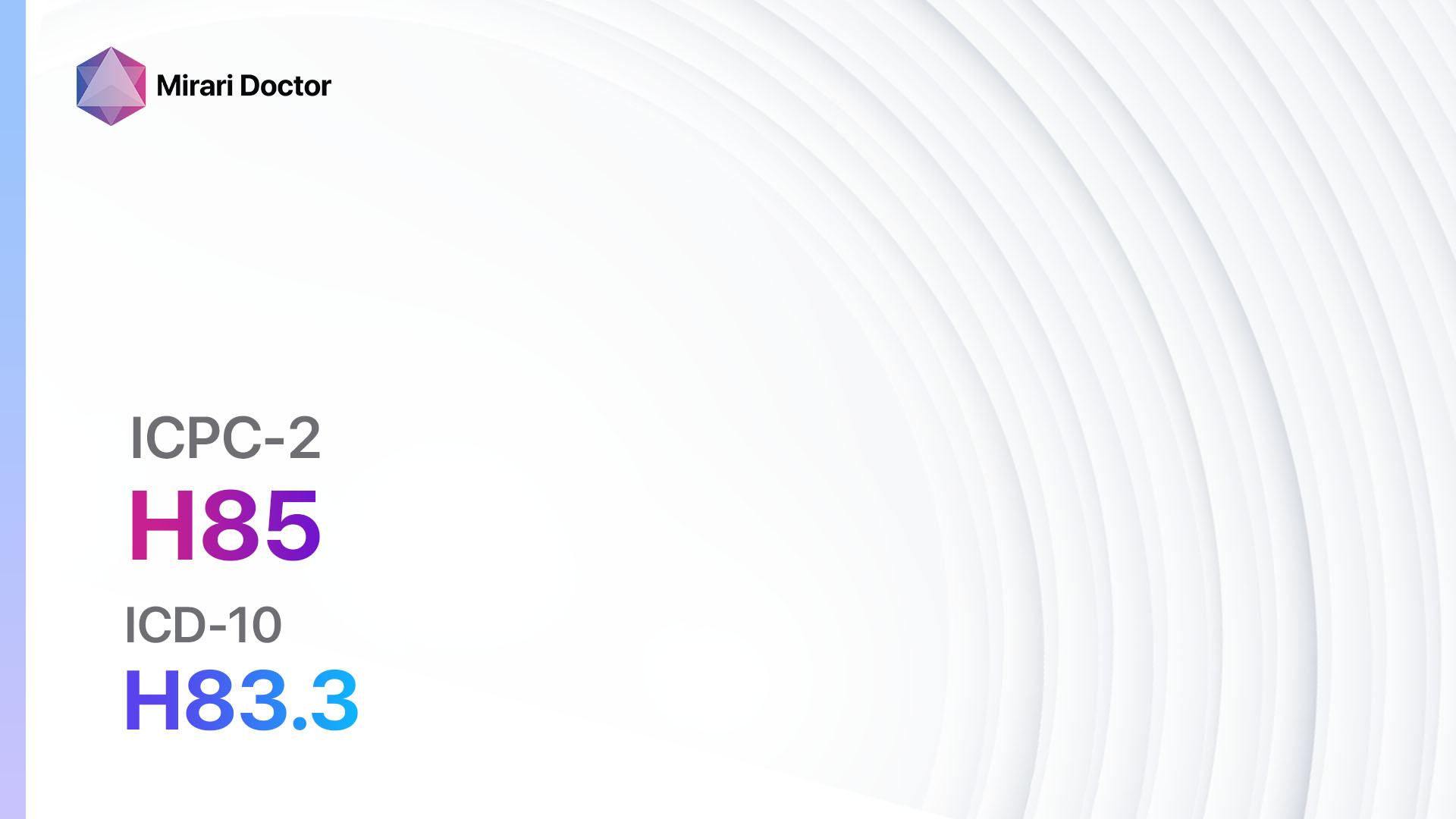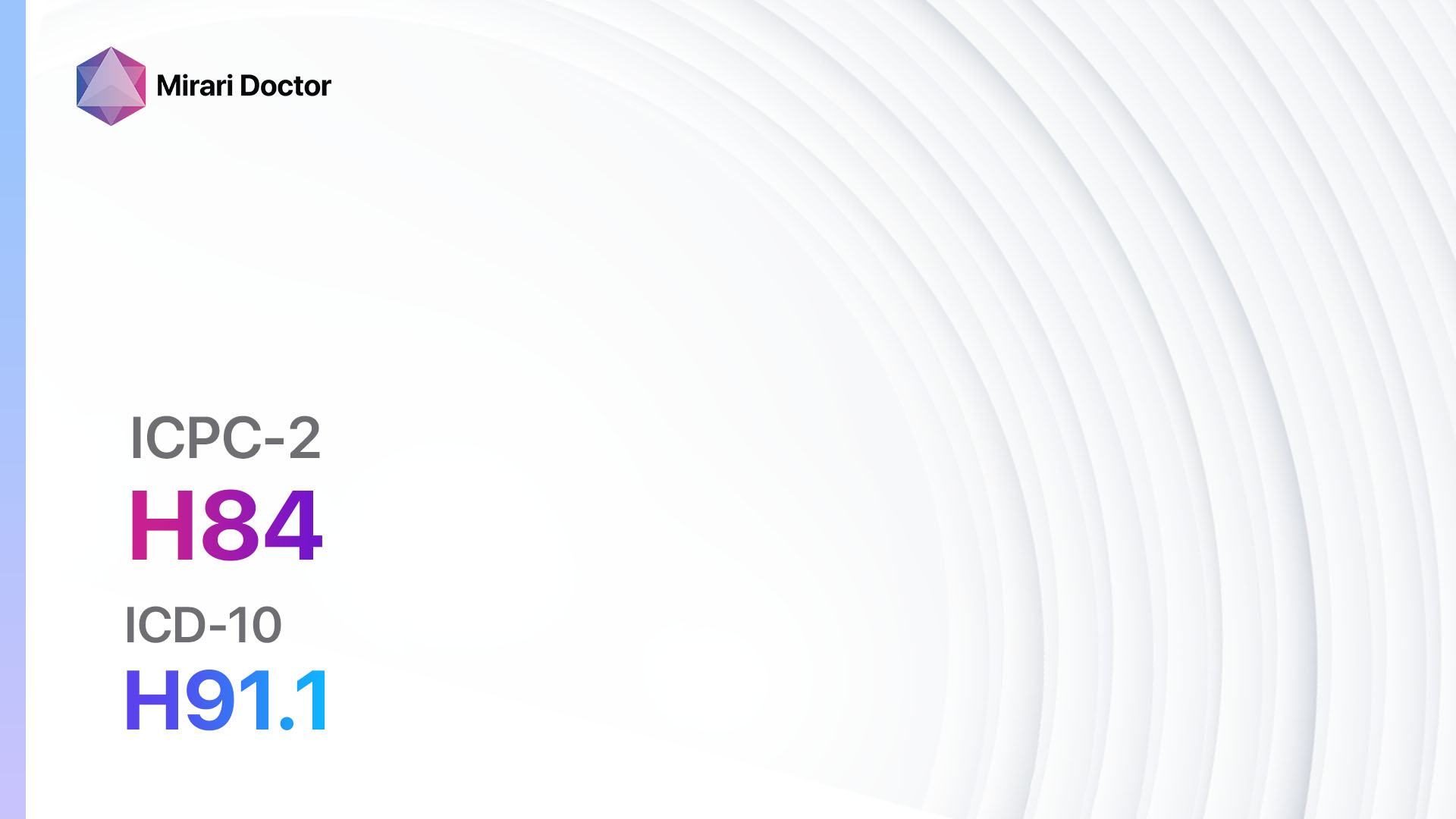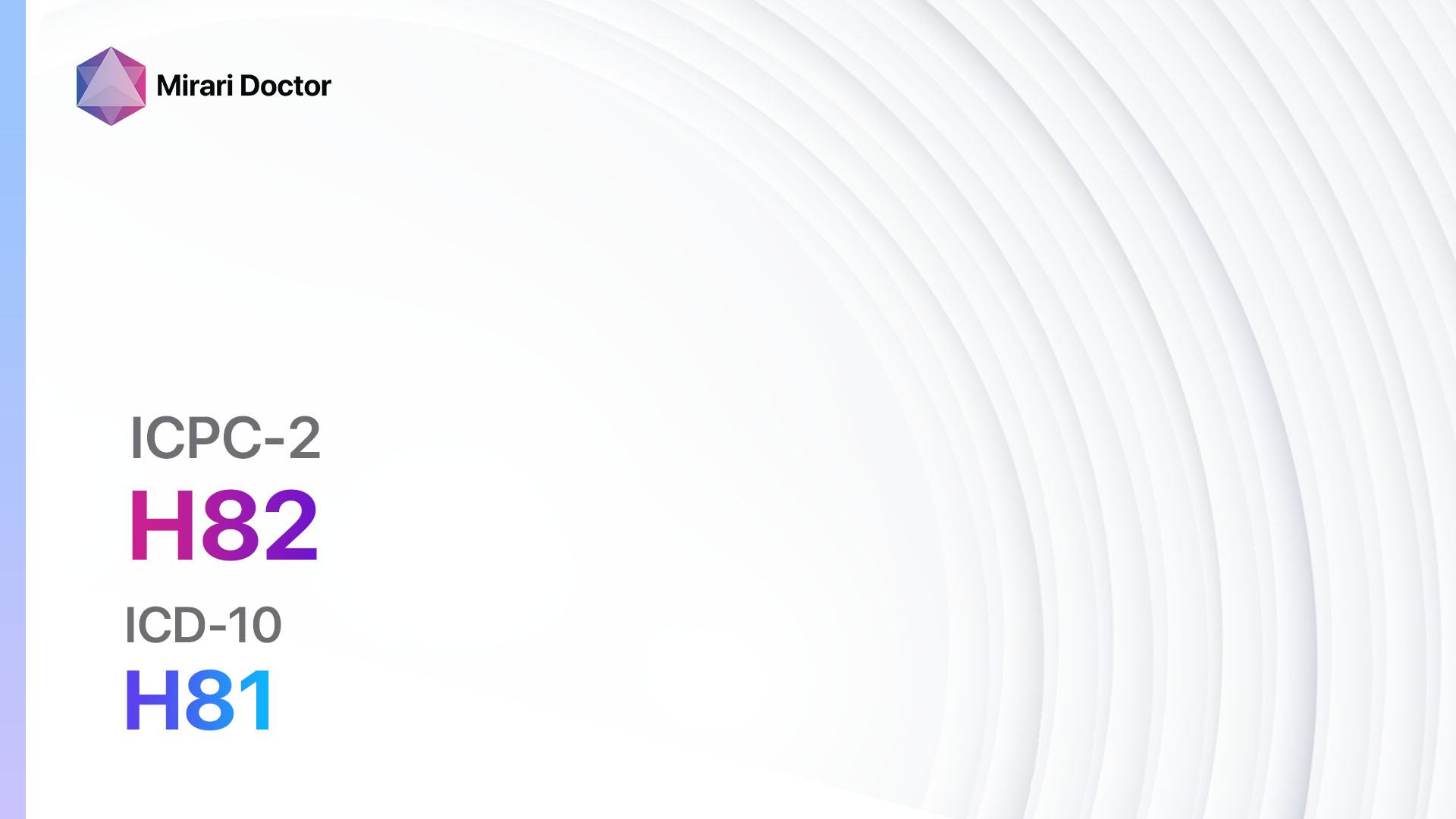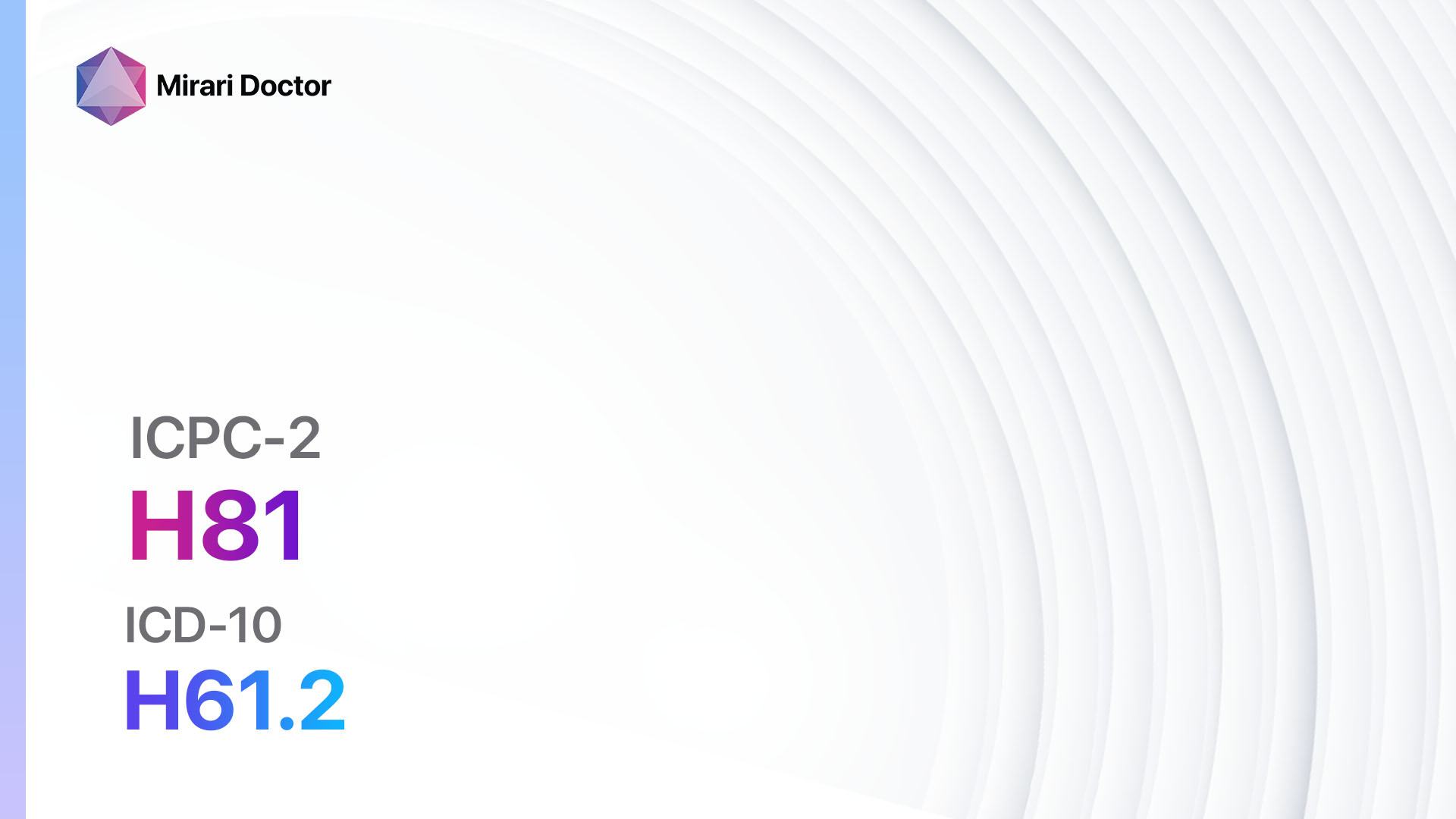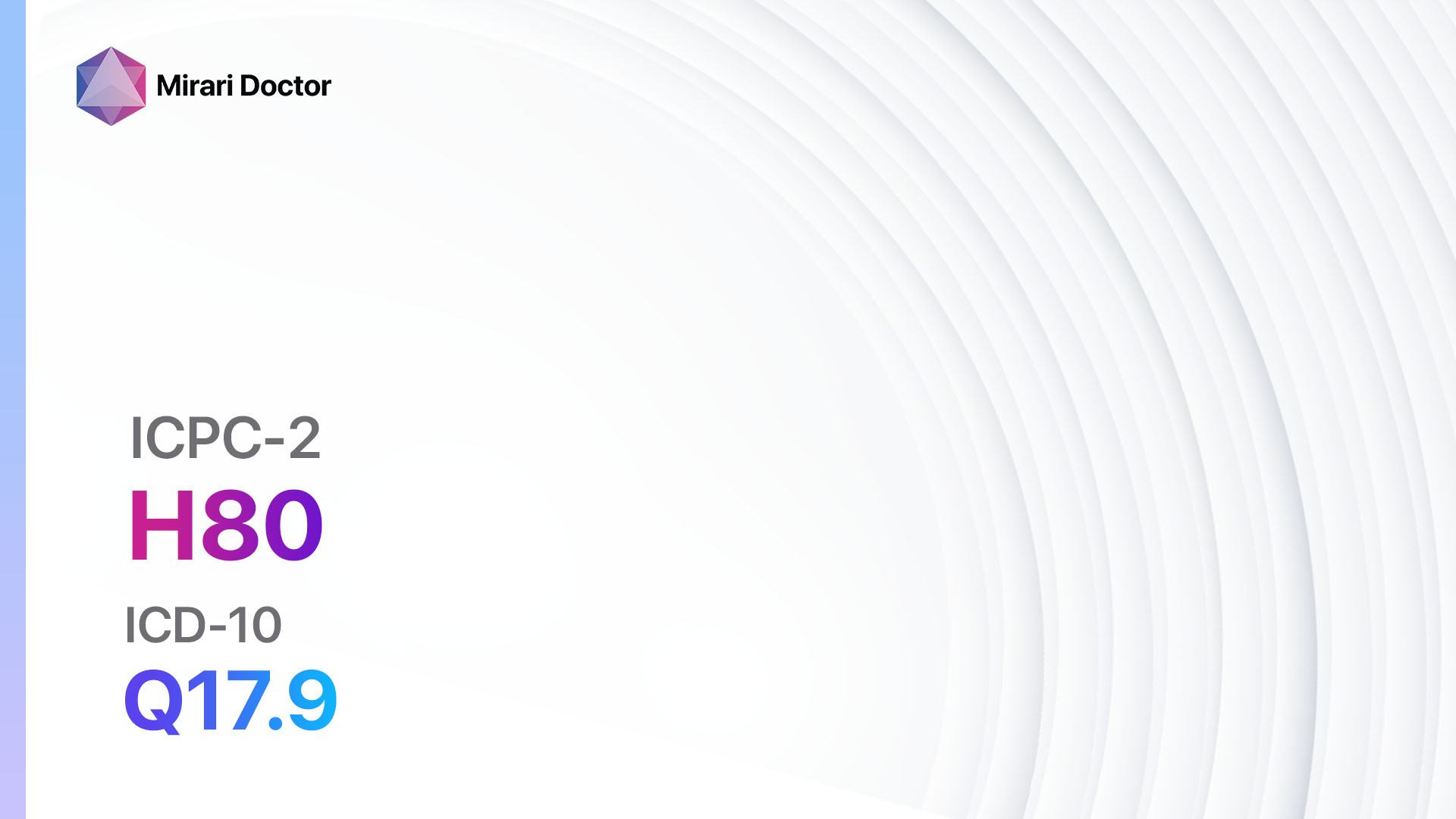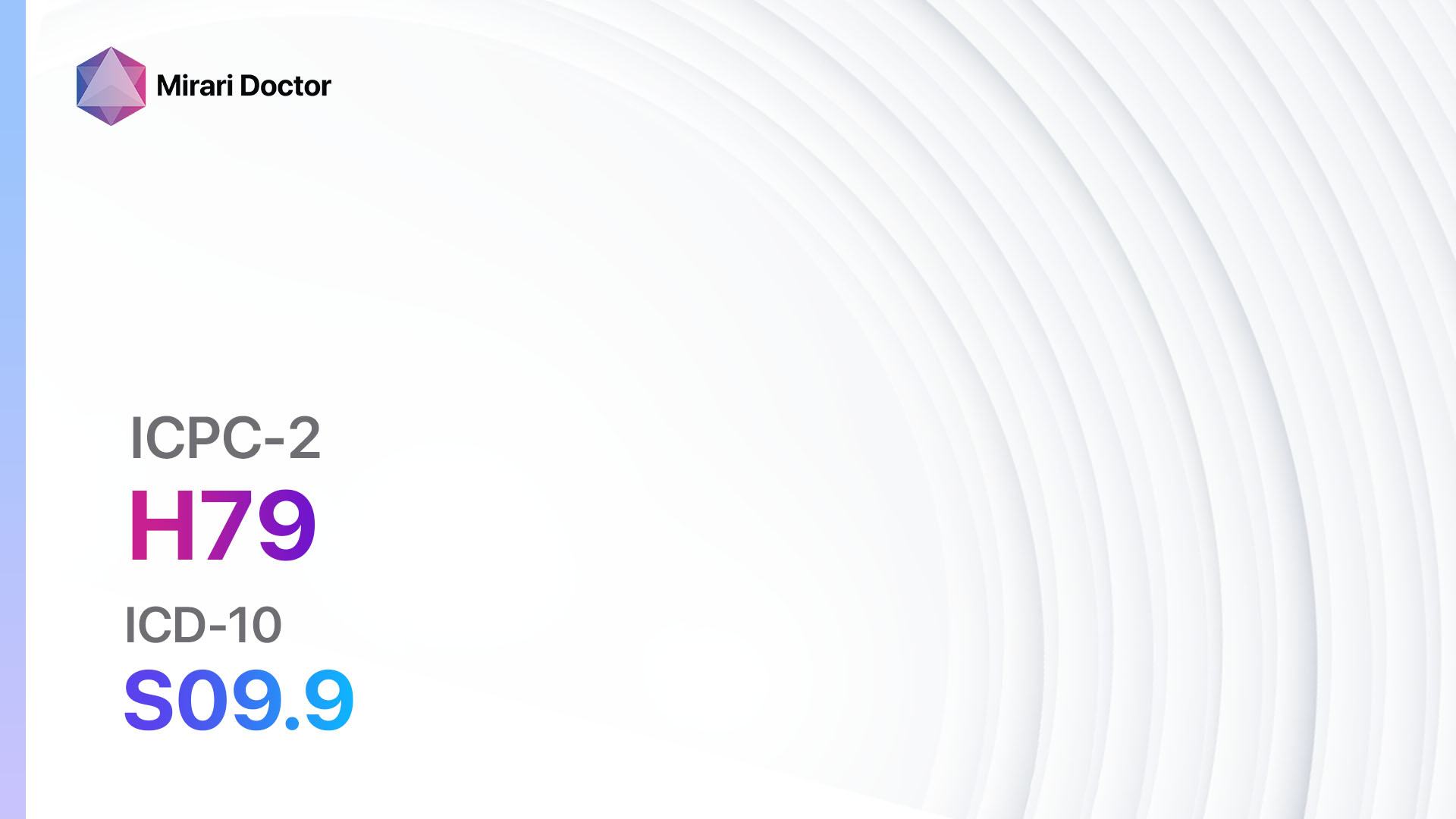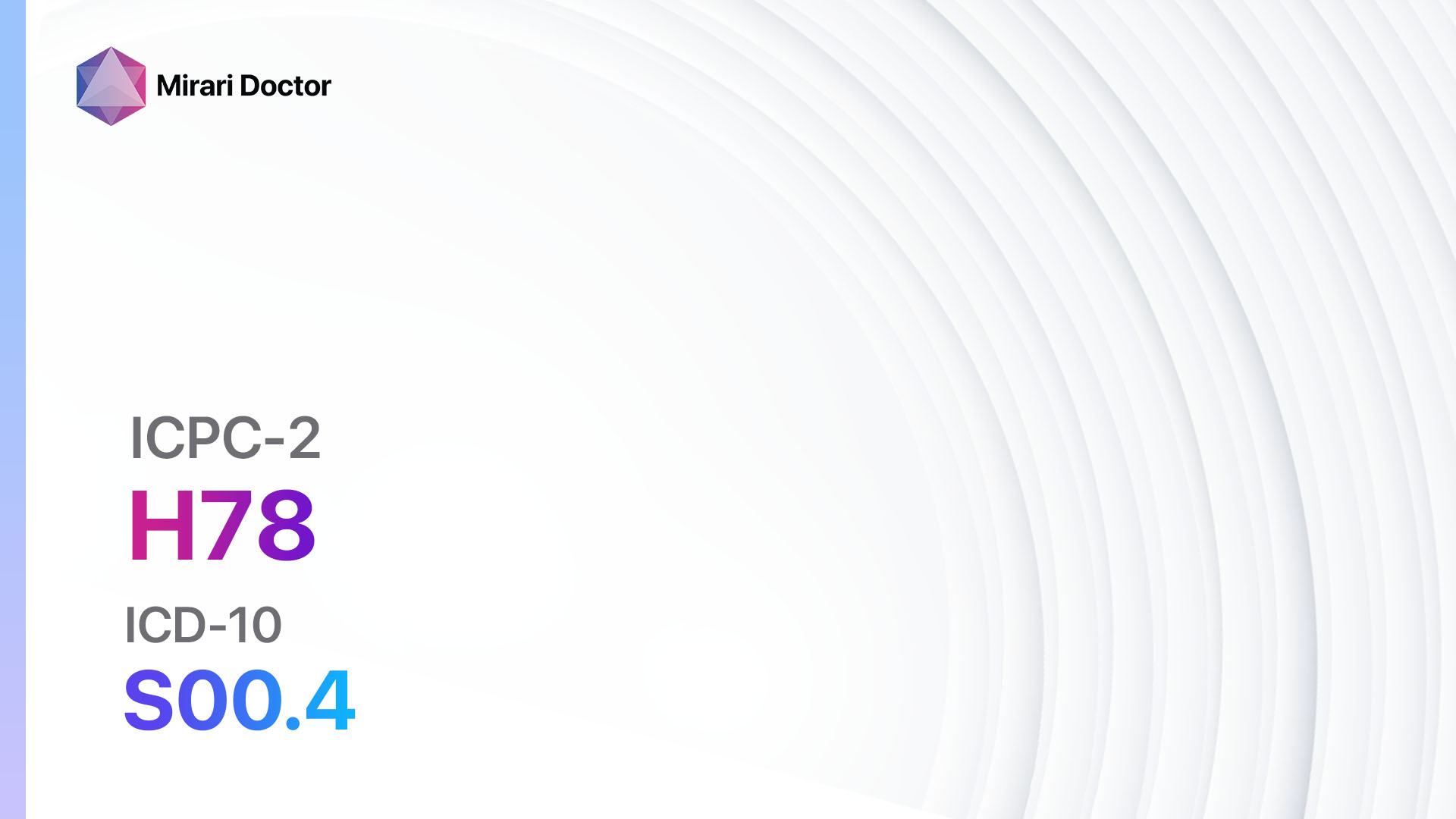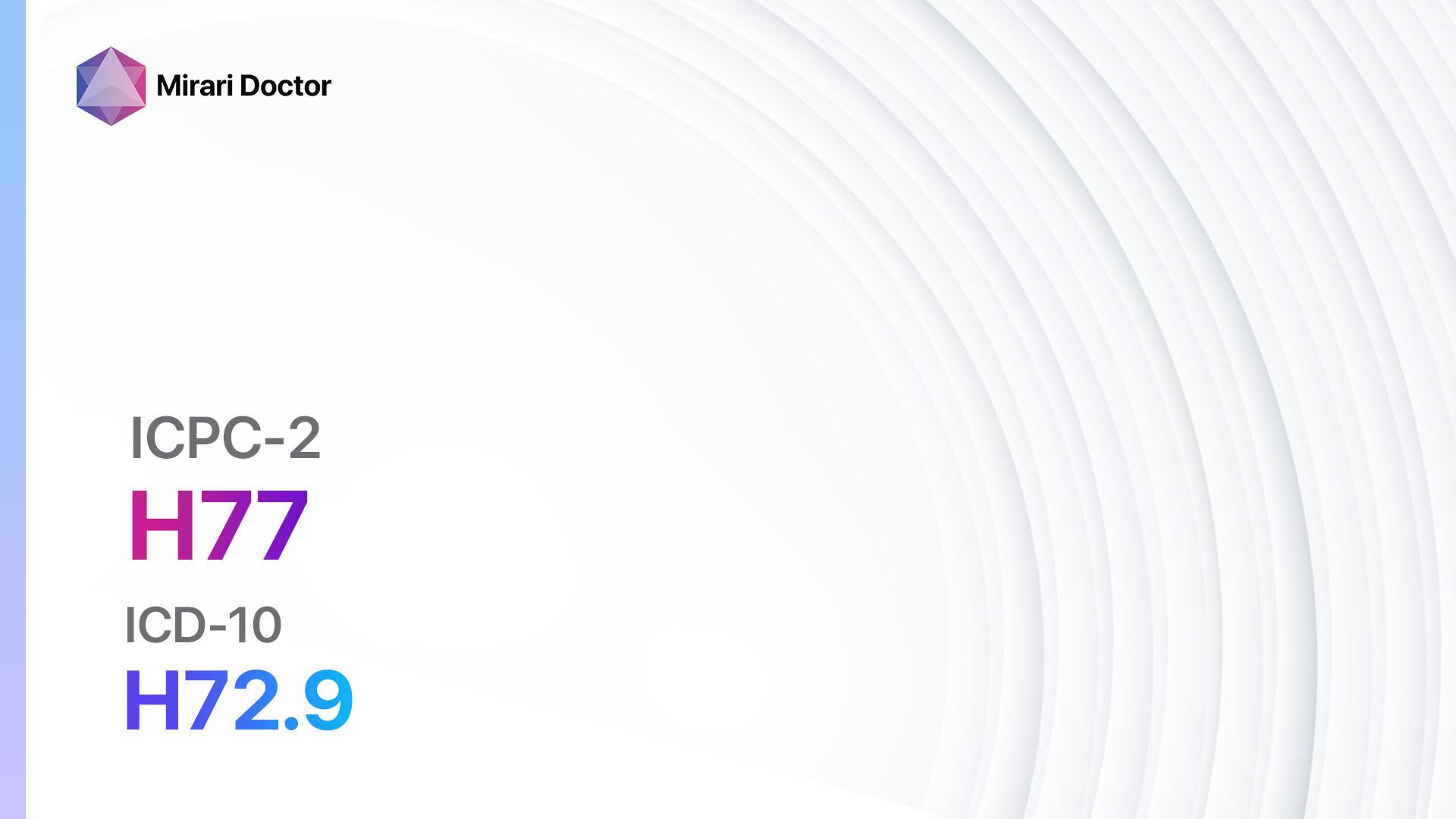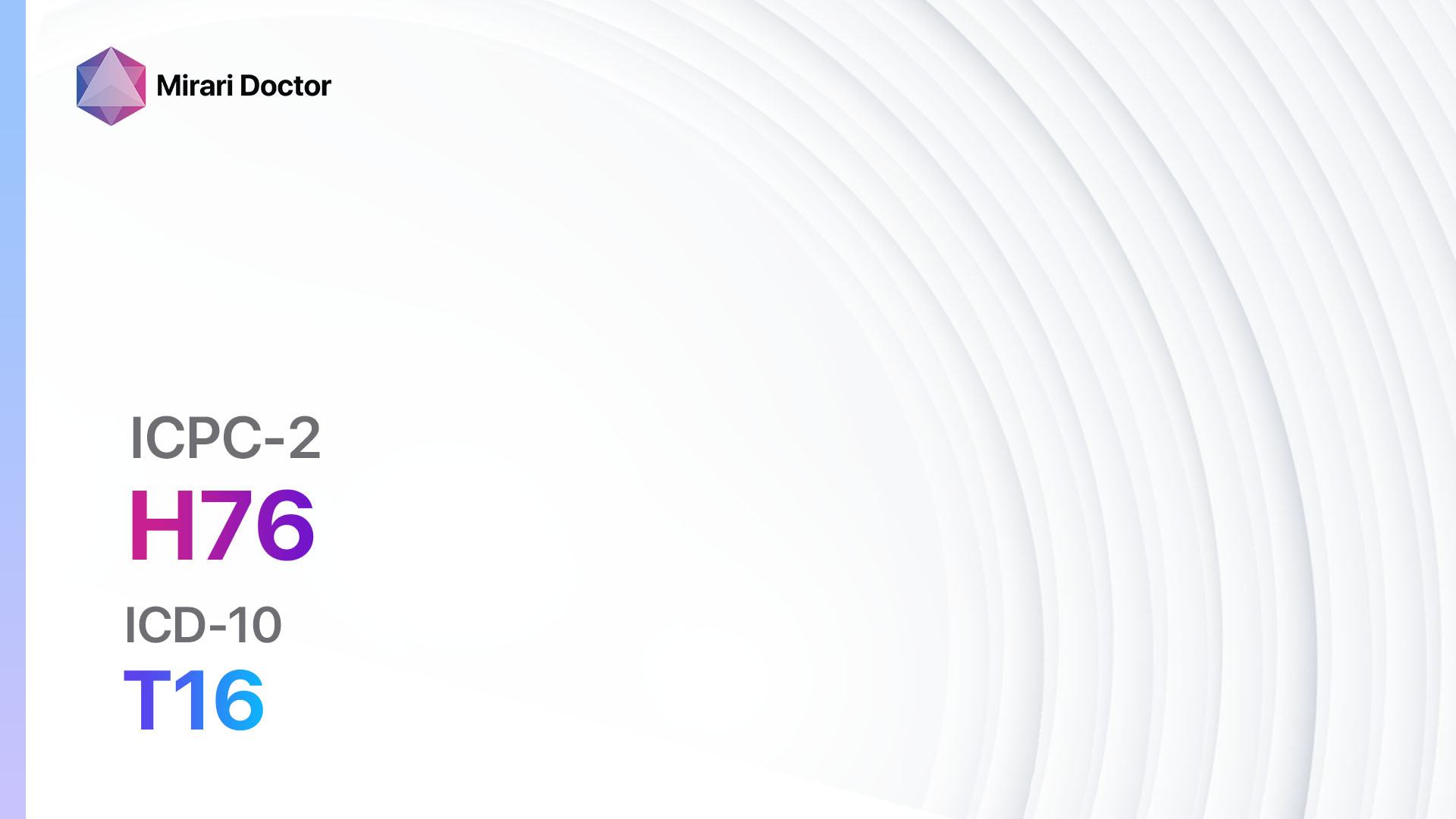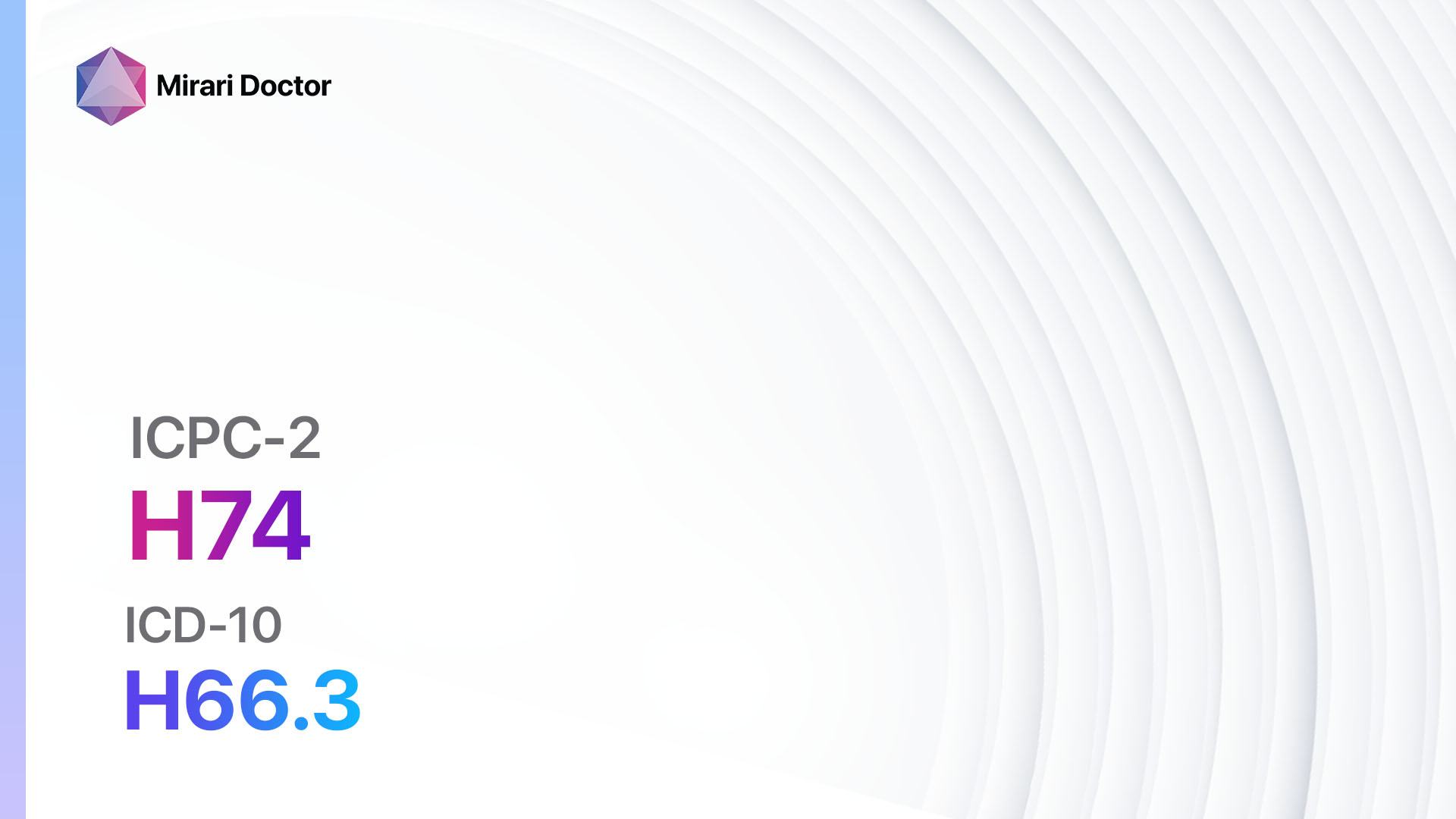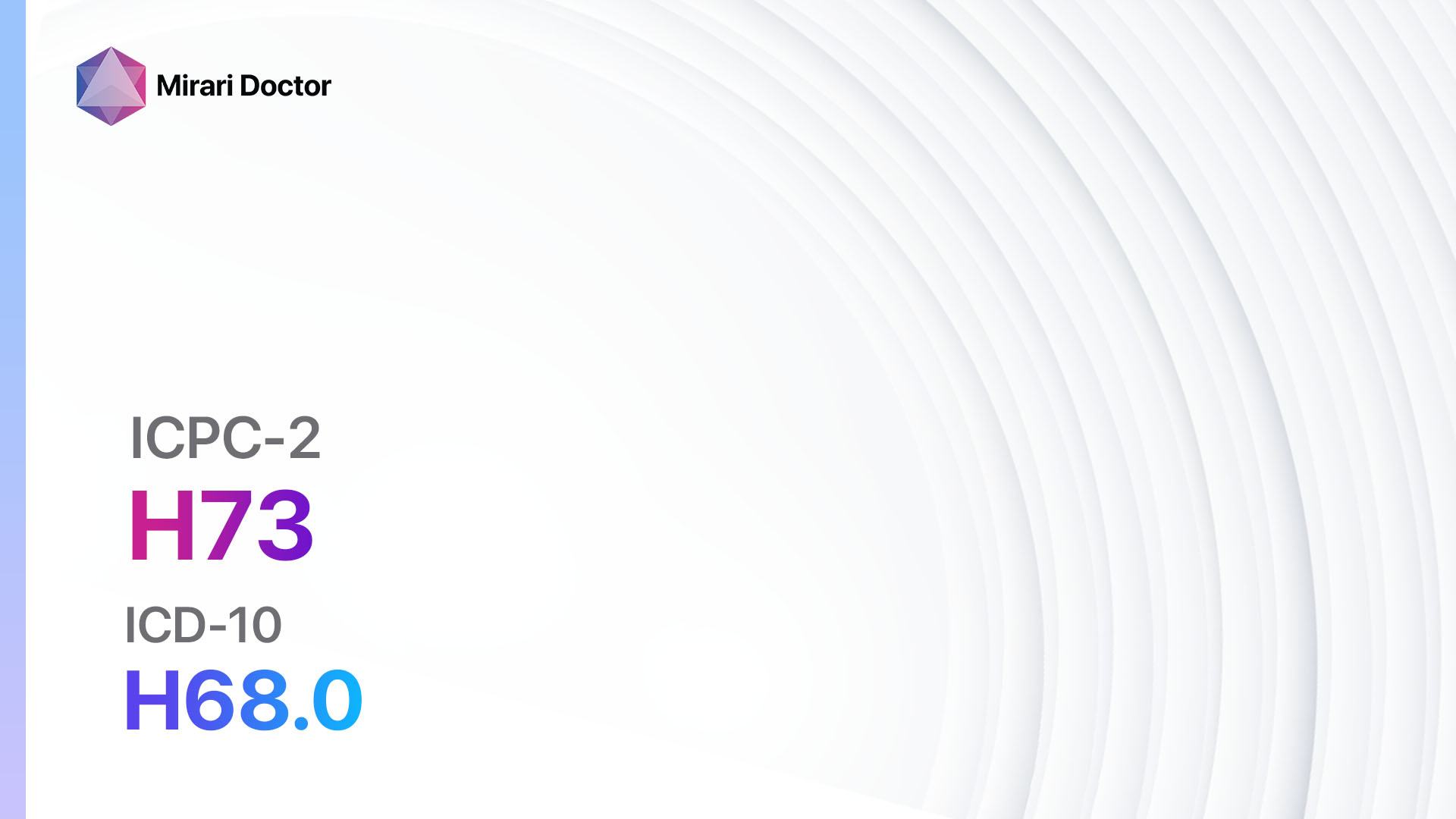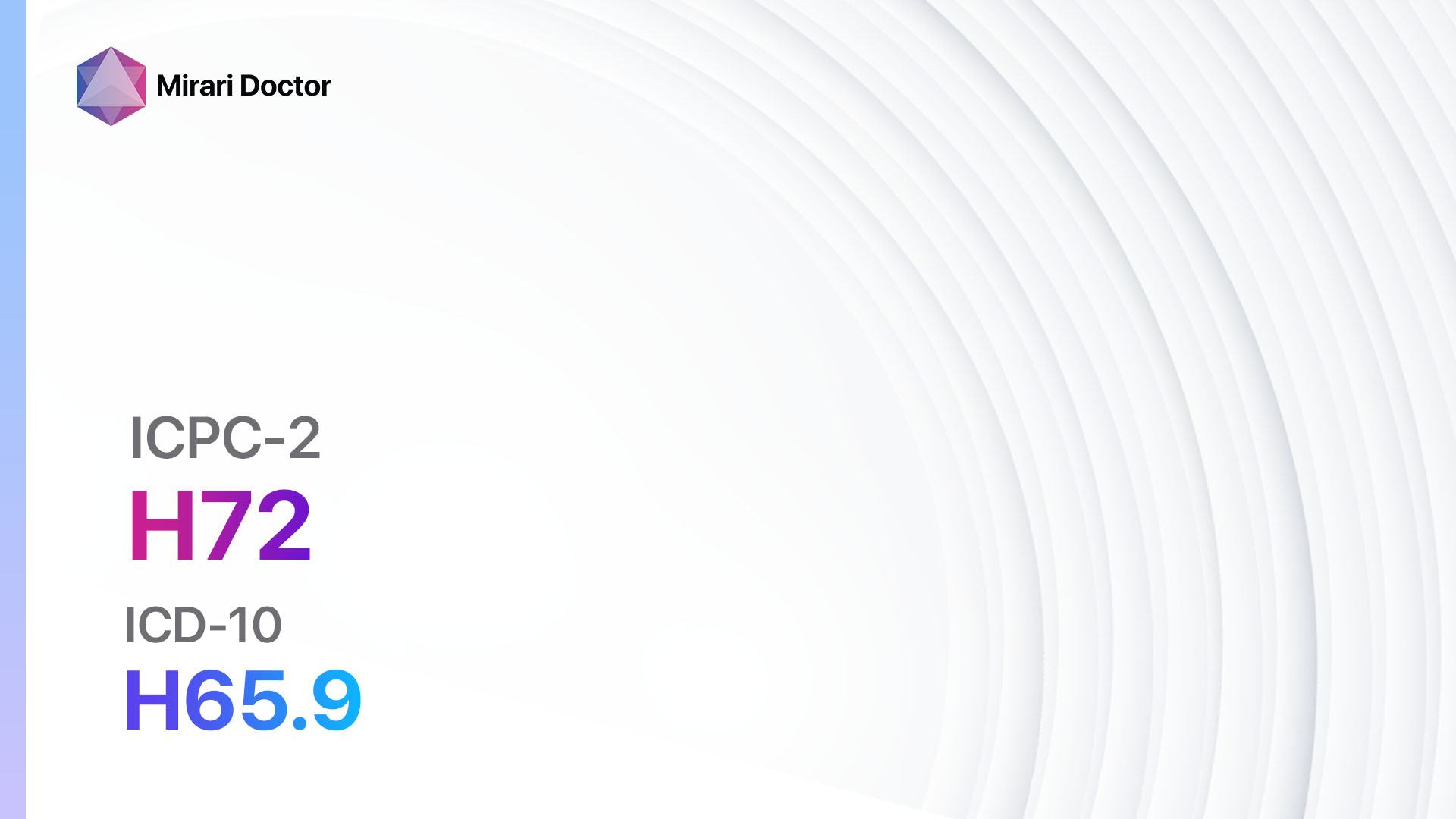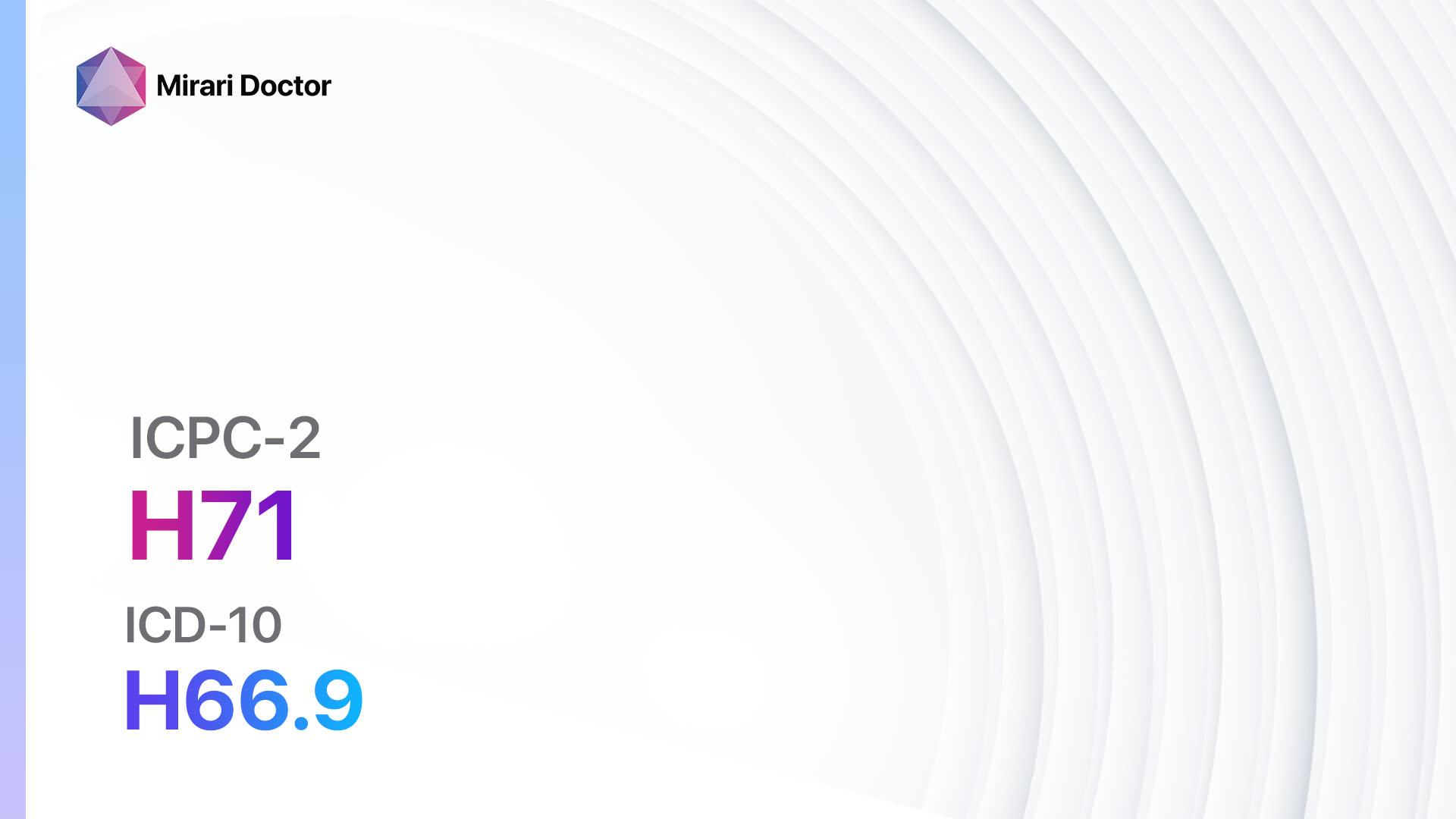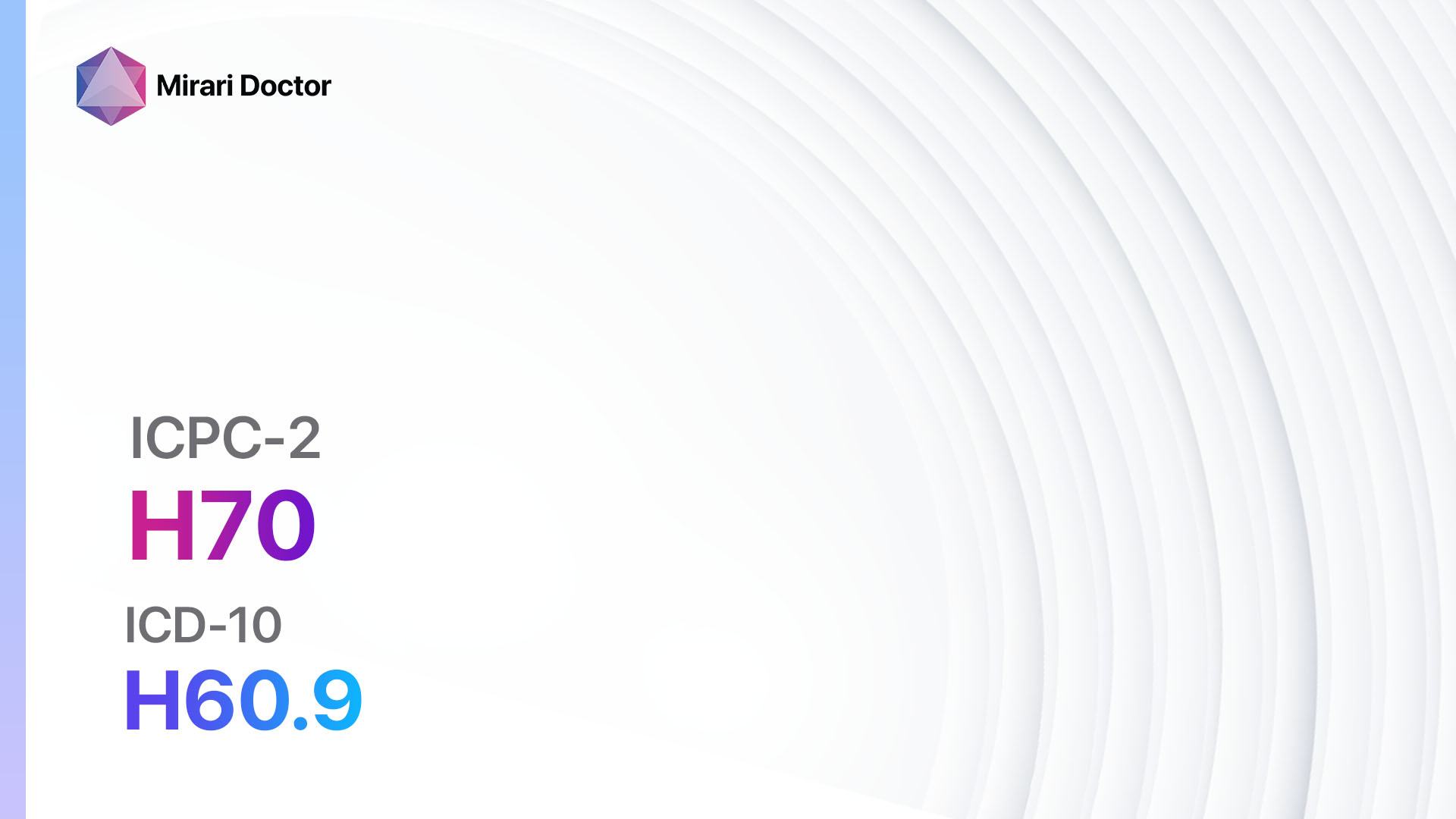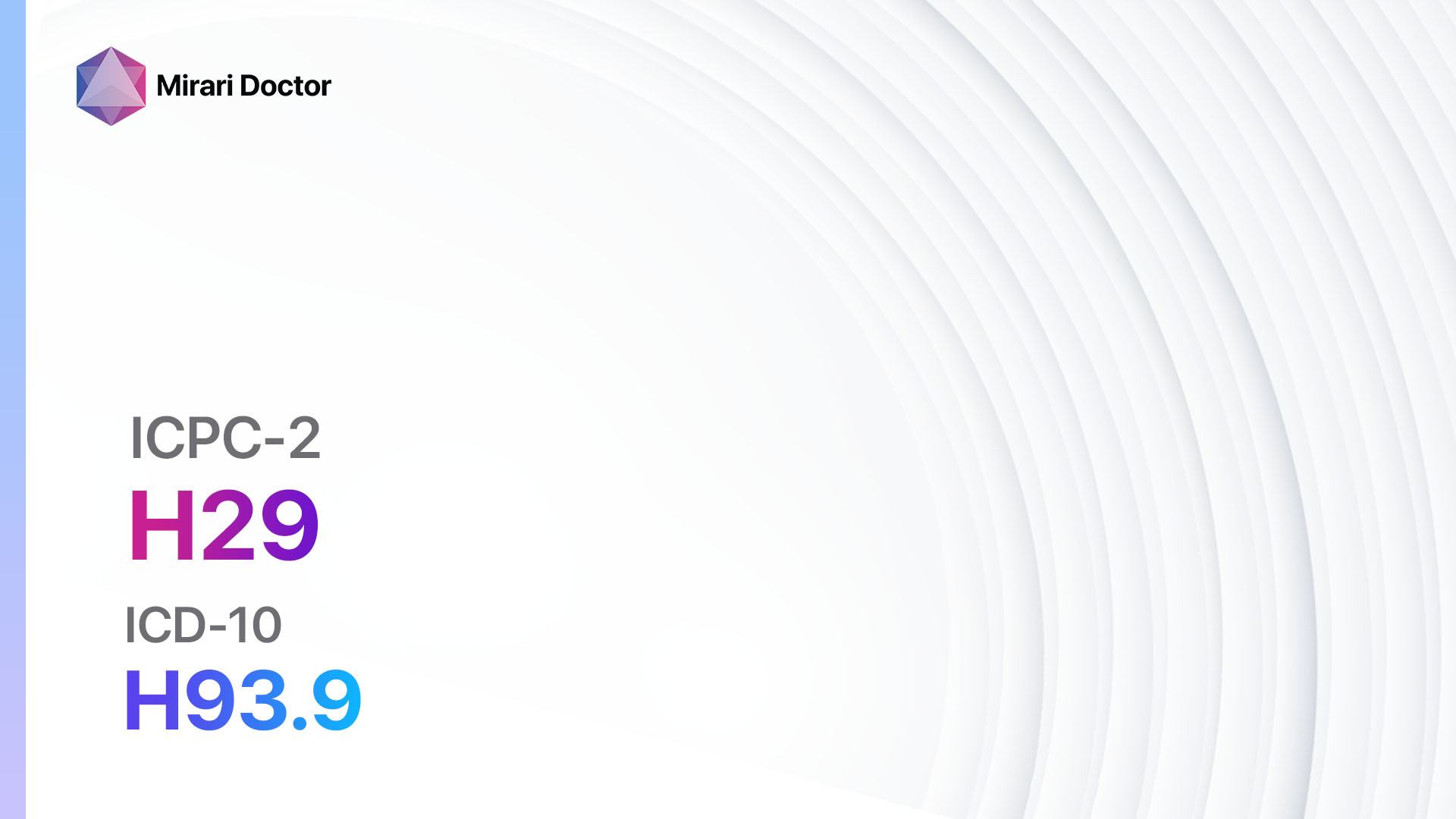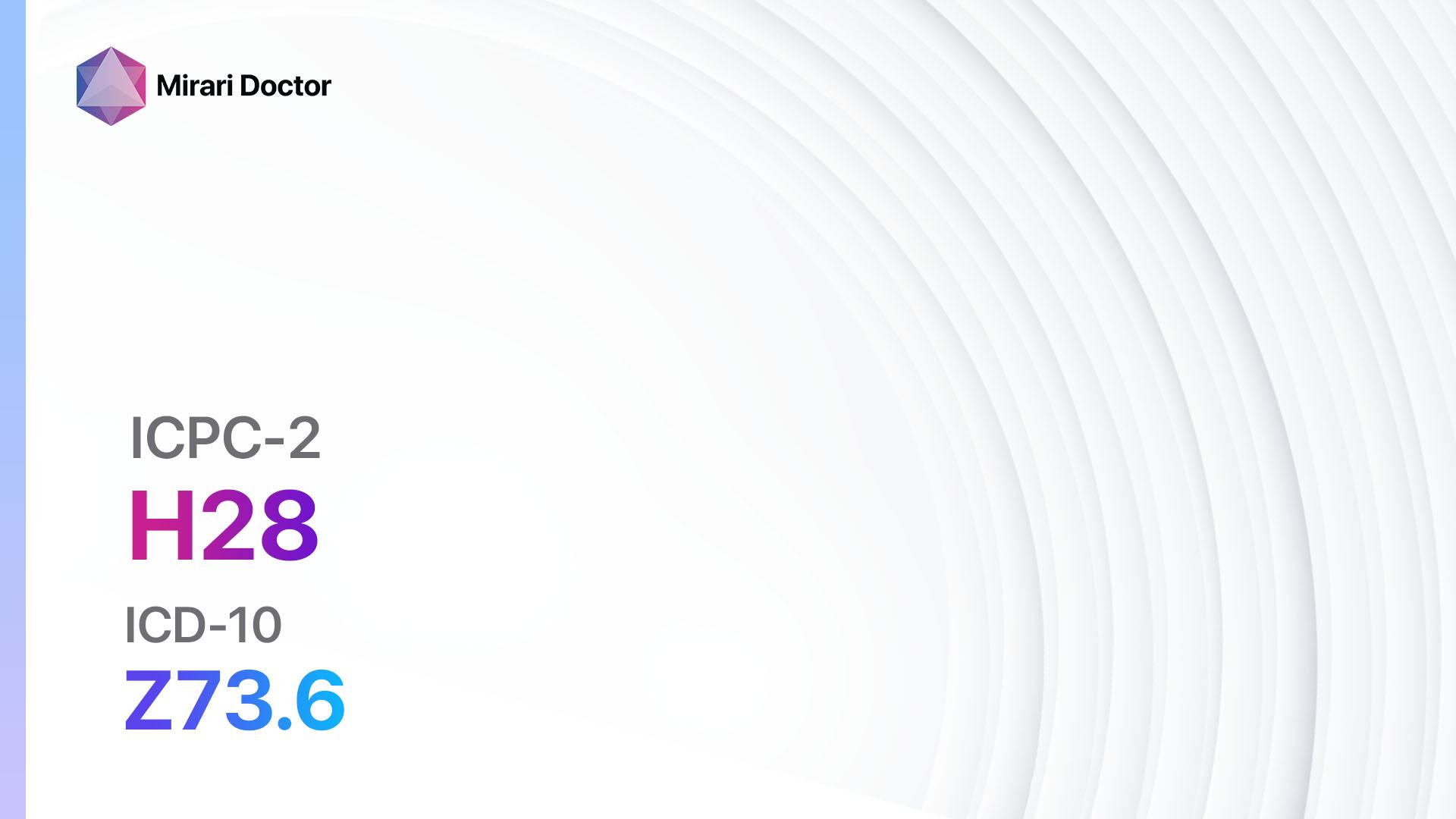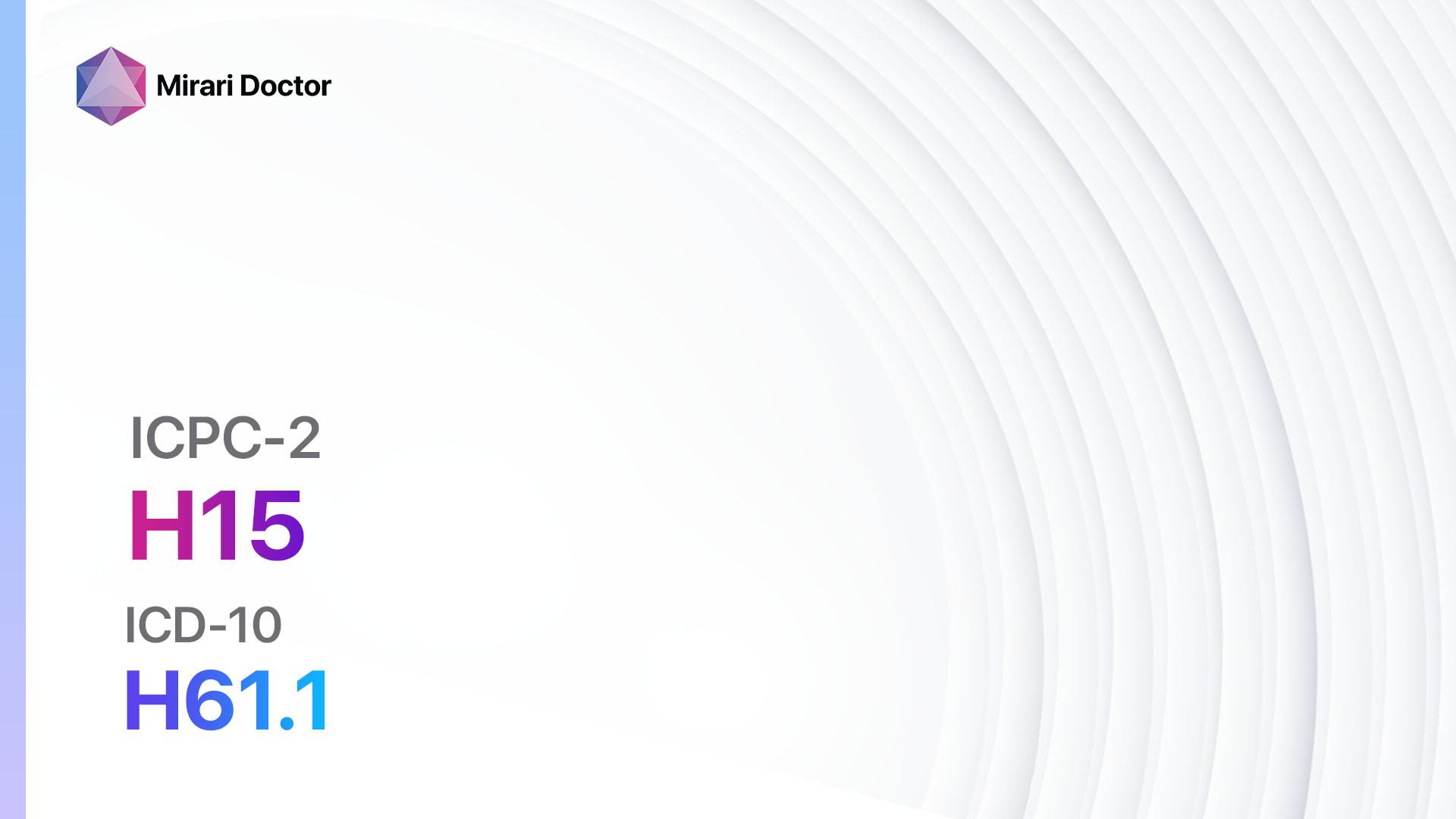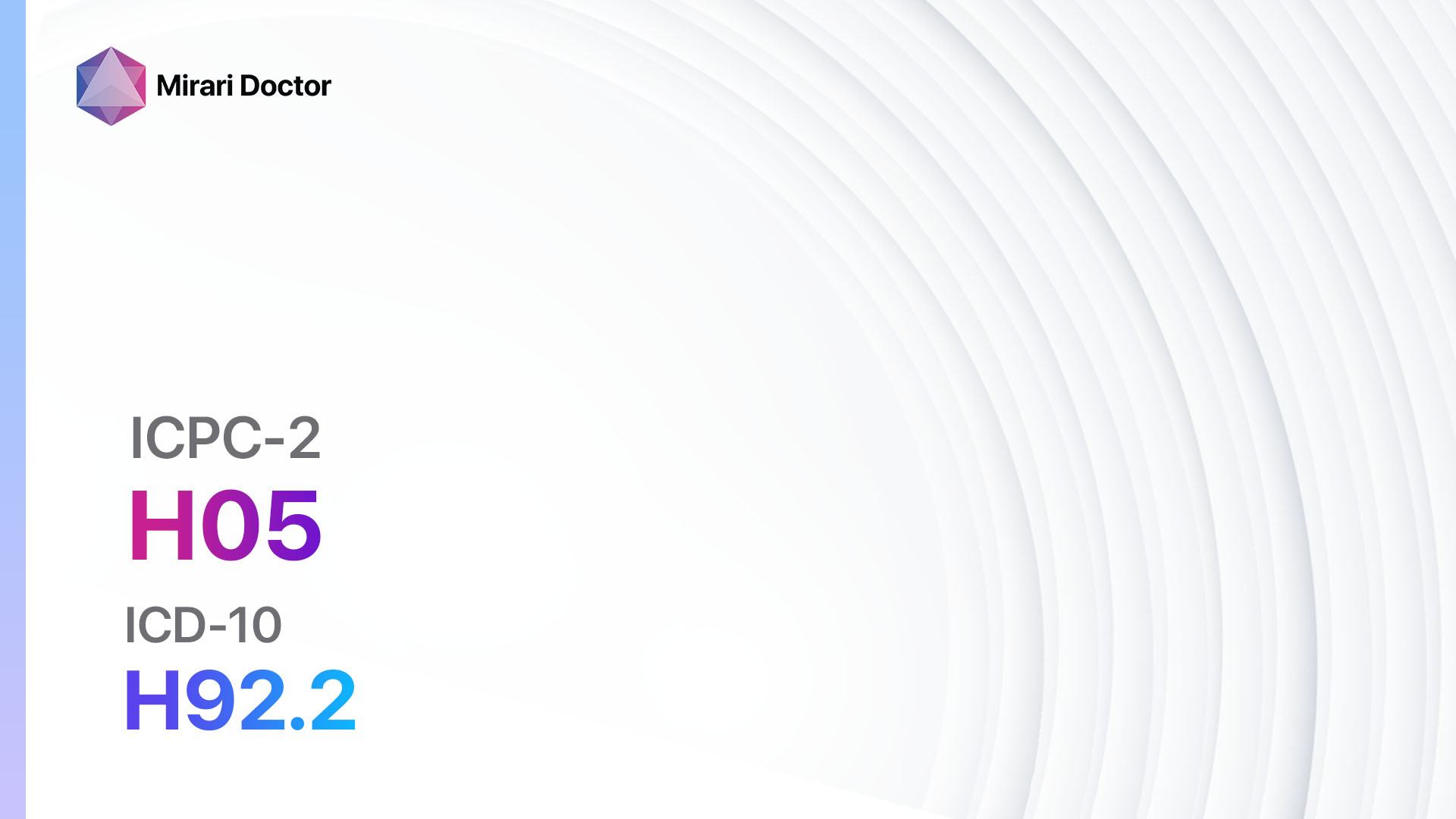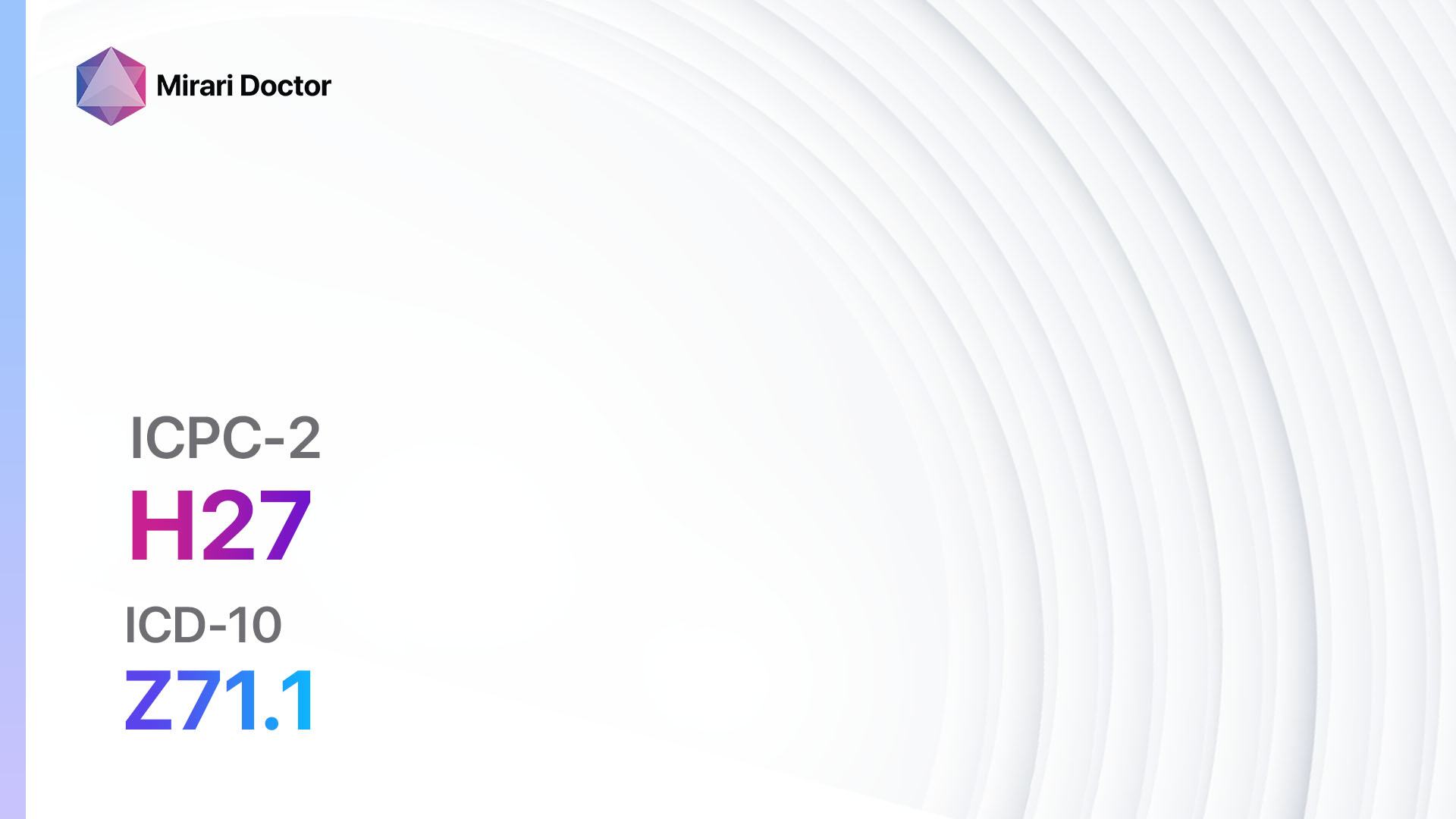
Introduction
Fear of ear disease (ICPC-2: H27) is a condition characterized by an excessive and irrational fear or anxiety related to the possibility of developing an ear disease[1]. This fear can significantly impact a person’s daily life and may lead to avoidance of situations or activities that could potentially expose them to ear-related issues[2]. The aim of this guide is to provide healthcare professionals with a comprehensive overview of the symptoms, causes, diagnostic steps, possible interventions, and patient education strategies for fear of ear disease.
Codes
- ICPC-2 Code: H27 Fear of ear disease[3]
- ICD-10 Code: Z71.1 Person with feared complaint in whom no diagnosis is made[4]
Symptoms
- Excessive worry or fear about developing an ear disease[5]
- Avoidance of situations or activities that could potentially expose the individual to ear-related issues[6]
- Physical symptoms such as increased heart rate, sweating, trembling, or shortness of breath when exposed to triggers related to ear disease[7]
Causes
- Previous traumatic experience related to ear disease[8]
- Family history of ear diseases[9]
- Lack of knowledge or understanding about ear health and diseases[10]
- Anxiety or phobia related to medical procedures or healthcare settings
Diagnostic Steps
Medical History
- Conduct a comprehensive medical history to gather relevant patient information, including:
- Previous experiences or traumas related to ear diseases
- Family history of ear diseases
- Any existing anxiety or phobias related to medical procedures or healthcare settings
- Knowledge or understanding about ear health and diseases
Physical Examination
- Perform a thorough physical examination, focusing on:
- Assessing the overall health of the ears, including the external ear, ear canal, and eardrum
- Checking for any signs of infection, inflammation, or abnormalities in the ears
- Evaluating the hearing function
Laboratory Tests
- No specific laboratory tests are required for the diagnosis of fear of ear disease. However, if there are any symptoms or signs of an actual ear disease, appropriate laboratory tests may be conducted to confirm the diagnosis.
Diagnostic Imaging
- Diagnostic imaging is not typically necessary for the diagnosis of fear of ear disease. However, if there are any symptoms or signs of an actual ear disease, imaging modalities such as X-rays, ultrasound, CT scans, or MRIs may be used to visualize and assess the condition of the ears.
Other Tests
- No other specific diagnostic tests are required for the diagnosis of fear of ear disease. However, additional tests or procedures may be necessary based on the clinical presentation and the presence of any actual ear diseases.
Follow-up and Patient Education
- Schedule regular follow-up appointments to monitor the patient’s progress and address any concerns or questions they may have.
- Provide patient education materials or resources about ear health, common ear diseases, and preventive measures to reduce the risk of developing ear diseases.
- Offer counseling or therapy sessions to help the patient overcome their fear or anxiety related to ear diseases.
Possible Interventions
Traditional Interventions
Medications:
Top 5 drugs for fear of ear disease:
- Selective serotonin reuptake inhibitors (SSRIs) (e.g., Sertraline, Fluoxetine):
- Cost: Generic versions can be $3-$50/month.
- Contraindications: Hypersensitivity to SSRIs, concurrent use of monoamine oxidase inhibitors (MAOIs).
- Side effects: Nausea, headache, insomnia.
- Severe side effects: Serotonin syndrome, suicidal thoughts.
- Drug interactions: MAOIs, other serotonergic drugs.
- Warning: Regular monitoring for the emergence of suicidal thoughts or behaviors is necessary.
- Benzodiazepines (e.g., Alprazolam, Diazepam):
- Cost: Generic versions can be $3-$50/month.
- Contraindications: Acute narrow-angle glaucoma, severe respiratory insufficiency.
- Side effects: Drowsiness, dizziness, confusion.
- Severe side effects: Respiratory depression, paradoxical reactions.
- Drug interactions: Alcohol, other CNS depressants.
- Warning: Risk of dependence and withdrawal symptoms with long-term use.
- Beta-blockers (e.g., Propranolol, Atenolol):
- Cost: Generic versions are typically <$30/month.
- Contraindications: Severe bradycardia, heart block greater than first degree.
- Side effects: Fatigue, dizziness, bradycardia.
- Severe side effects: Bronchospasm, heart failure exacerbation.
- Drug interactions: Calcium channel blockers, insulin.
- Warning: Should not be abruptly stopped.
- Antidepressants (e.g., Amitriptyline, Nortriptyline):
- Cost: Generic versions can be $3-$50/month.
- Contraindications: Recent myocardial infarction, concurrent use of MAOIs.
- Side effects: Dry mouth, constipation, blurred vision.
- Severe side effects: Cardiac arrhythmias, serotonin syndrome.
- Drug interactions: MAOIs, other serotonergic drugs.
- Warning: Regular monitoring for the emergence of suicidal thoughts or behaviors is necessary.
- Antipsychotics (e.g., Quetiapine, Risperidone):
- Cost: Generic versions can be $3-$50/month.
- Contraindications: Severe CNS depression, dementia-related psychosis.
- Side effects: Sedation, weight gain, extrapyramidal symptoms.
- Severe side effects: Neuroleptic malignant syndrome, tardive dyskinesia.
- Drug interactions: Other antipsychotics, CNS depressants.
- Warning: Increased risk of mortality in elderly patients with dementia-related psychosis.
Alternative Drugs:
- Herbal supplements (e.g., Valerian root, Passionflower): May have calming effects and help reduce anxiety. Cost: Varies depending on the specific supplement.
- Homeopathic remedies (e.g., Aconitum napellus, Gelsemium): Some individuals find relief from anxiety symptoms with homeopathic treatments. Cost: Varies depending on the specific remedy.
- Cognitive-behavioral therapy (CBT): A non-pharmacological intervention that focuses on identifying and changing negative thought patterns and behaviors associated with fear of ear disease. Cost: Varies depending on the therapist and location.
Surgical Procedures:
- Surgical procedures are not typically indicated for the treatment of fear of ear disease. However, in cases where there are actual ear diseases present, surgical interventions may be necessary to address the underlying condition.
Alternative Interventions
- Counseling or therapy sessions: Individual or group therapy sessions can help individuals address their fear of ear disease and develop coping mechanisms. Cost: Varies depending on the therapist and location.
- Relaxation techniques: Techniques such as deep breathing exercises, meditation, or yoga can help reduce anxiety and promote relaxation. Cost: Varies depending on the specific practice or class.
- Hypnotherapy: Hypnosis can be used to address the underlying fears and anxieties related to ear diseases. Cost: Varies depending on the therapist and location.
- Support groups: Joining a support group with individuals who have similar fears or experiences can provide a sense of community and understanding. Cost: Varies depending on the specific group or organization.
- Acupuncture: May help reduce anxiety and promote overall well-being. Cost: $60-$120 per session.
Lifestyle Interventions
- Education and self-help resources: Providing educational materials and resources about ear health, common ear diseases, and preventive measures can empower individuals to take control of their fears and anxieties. Cost: Varies depending on the specific resources.
- Regular exercise: Engaging in regular physical activity can help reduce anxiety and promote overall well-being. Cost: Varies depending on the specific exercise routine or gym membership.
- Stress management techniques: Learning and practicing stress management techniques, such as mindfulness or journaling, can help individuals cope with their fears and anxieties. Cost: Varies depending on the specific technique or class.
- Healthy lifestyle choices: Encouraging individuals to maintain a healthy lifestyle, including a balanced diet, adequate sleep, and avoidance of excessive alcohol or drug use, can contribute to overall well-being and reduce anxiety. Cost: Varies depending on individual choices and preferences.
It is important to note that the cost ranges provided are approximate and may vary depending on the location and availability of the interventions. It is recommended to consult with healthcare professionals or insurance providers for specific cost information and coverage options.
Mirari Cold Plasma Alternative Intervention
Understanding Mirari Cold Plasma
- Safe and Non-Invasive Treatment: Mirari Cold Plasma is a safe and non-invasive treatment option for various skin conditions. It does not require incisions, minimizing the risk of scarring, bleeding, or tissue damage.
- Efficient Extraction of Foreign Bodies: Mirari Cold Plasma facilitates the removal of foreign bodies from the skin by degrading and dissociating organic matter, allowing easier access and extraction.
- Pain Reduction and Comfort: Mirari Cold Plasma has a local analgesic effect, providing pain relief during the treatment, making it more comfortable for the patient.
- Reduced Risk of Infection: Mirari Cold Plasma has antimicrobial properties, effectively killing bacteria and reducing the risk of infection.
- Accelerated Healing and Minimal Scarring: Mirari Cold Plasma stimulates wound healing and tissue regeneration, reducing healing time and minimizing the formation of scars.
Mirari Cold Plasma Prescription
Video instructions for using Mirari Cold Plasma Device – H27 Fear of ear disease (ICD-10:Z71.1)
| Mild | Moderate | Severe |
| Mode setting: 1 (Infection) Location: 0 (Localized) Morning: 15 minutes, Evening: 15 minutes | Mode setting: 1 (Infection) Location: 0 (Localized) Morning: 30 minutes, Lunch: 30 minutes, Evening: 30 minutes | Mode setting: 1 (Infection) Location: 0 (Localized) Morning: 30 minutes, Lunch: 30 minutes, Evening: 30 minutes |
| Mode setting: 2 (Wound Healing) Location: 0 (Localized) Morning: 15 minutes, Evening: 15 minutes | Mode setting: 2 (Wound Healing) Location: 0 (Localized) Morning: 30 minutes, Lunch: 30 minutes, Evening: 30 minutes | Mode setting: 2 (Wound Healing) Location: 0 (Localized) Morning: 30 minutes, Lunch: 30 minutes, Evening: 30 minutes |
| Mode setting: 3 (Antiviral Therapy) Location: 0 (Localized) Morning: 15 minutes, Evening: 15 minutes | Mode setting: 3 (Antiviral Therapy) Location: 0 (Localized) Morning: 30 minutes, Lunch: 30 minutes, Evening: 30 minutes | Mode setting: 3 (Antiviral Therapy) Location: 0 (Localized) Morning: 30 minutes, Lunch: 30 minutes, Evening: 30 minutes |
| Total Morning: 45 minutes approx. $7.50 USD, Evening: 45 minutes approx. $7.50 USD | Total Morning: 90 minutes approx. $15 USD, Lunch: 90 minutes approx. $15 USD, Evening: 90 minutes approx. $15 USD, | Total Morning: 90 minutes approx. $15 USD, Lunch: 90 minutes approx. $15 USD, Evening: 90 minutes approx. $15 USD, |
| Usual treatment for 7-60 days approx. $105 USD – $900 USD | Usual treatment for 6-8 weeks approx. $1,890USD – $2,520 USD | Usual treatment for 3-6 months approx. $4,050 USD – $8,100 USD |
 |
|
Use the Mirari Cold Plasma device to treat Fear of ear disease effectively.
WARNING: MIRARI COLD PLASMA IS DESIGNED FOR THE HUMAN BODY WITHOUT ANY ARTIFICIAL OR THIRD PARTY PRODUCTS. USE OF OTHER PRODUCTS IN COMBINATION WITH MIRARI COLD PLASMA MAY CAUSE UNPREDICTABLE EFFECTS, HARM OR INJURY. PLEASE CONSULT A MEDICAL PROFESSIONAL BEFORE COMBINING ANY OTHER PRODUCTS WITH USE OF MIRARI.
Step 1: Cleanse the Skin
- Start by cleaning the affected area of the skin with a gentle cleanser or mild soap and water. Gently pat the area dry with a clean towel.
Step 2: Prepare the Mirari Cold Plasma device
- Ensure that the Mirari Cold Plasma device is fully charged or has fresh batteries as per the manufacturer’s instructions. Make sure the device is clean and in good working condition.
- Switch on the Mirari device using the power button or by following the specific instructions provided with the device.
- Some Mirari devices may have adjustable settings for intensity or treatment duration. Follow the manufacturer’s instructions to select the appropriate settings based on your needs and the recommended guidelines.
Step 3: Apply the Device
- Place the Mirari device in direct contact with the affected area of the skin. Gently glide or hold the device over the skin surface, ensuring even coverage of the area experiencing.
- Slowly move the Mirari device in a circular motion or follow a specific pattern as indicated in the user manual. This helps ensure thorough treatment coverage.
Step 4: Monitor and Assess:
- Keep track of your progress and evaluate the effectiveness of the Mirari device in managing your Fear of ear disease. If you have any concerns or notice any adverse reactions, consult with your health care professional.
Note
This guide is for informational purposes only and should not replace the advice of a medical professional. Always consult with your healthcare provider or a qualified medical professional for personal advice, diagnosis, or treatment. Do not solely rely on the information presented here for decisions about your health. Use of this information is at your own risk. The authors of this guide, nor any associated entities or platforms, are not responsible for any potential adverse effects or outcomes based on the content.
Mirari Cold Plasma System Disclaimer
- Purpose: The Mirari Cold Plasma System is a Class 2 medical device designed for use by trained healthcare professionals. It is registered for use in Thailand and Vietnam. It is not intended for use outside of these locations.
- Informational Use: The content and information provided with the device are for educational and informational purposes only. They are not a substitute for professional medical advice or care.
- Variable Outcomes: While the device is approved for specific uses, individual outcomes can differ. We do not assert or guarantee specific medical outcomes.
- Consultation: Prior to utilizing the device or making decisions based on its content, it is essential to consult with a Certified Mirari Tele-Therapist and your medical healthcare provider regarding specific protocols.
- Liability: By using this device, users are acknowledging and accepting all potential risks. Neither the manufacturer nor the distributor will be held accountable for any adverse reactions, injuries, or damages stemming from its use.
- Geographical Availability: This device has received approval for designated purposes by the Thai and Vietnam FDA. As of now, outside of Thailand and Vietnam, the Mirari Cold Plasma System is not available for purchase or use.
References
- Little, CJ ; Lane, JG ; Pearson, GR (1991). Inflammatory middle ear disease of the dog: the pathology of otitis media. DOI: 10.1136/vr.128.13.293
- DAGAN, RON (2000). Clinical significance of resistant organisms in otitis media. DOI: 10.1097/00006454-200004000-00033
- BLUESTONE, C. D (1998). Role of surgery for otitis media in the era of resistant bacteria. DOI: 10.1097/00006454-199811000-00040
- GEHANNO, PIERRE ; PANAJOTOPOULOS, ALEXANDRA ; BARRY, BÉATRIX ; NGUYEN, LAURENCE ; LEVY, DELPHINE ; BINGEN, EDOUARD ; BERCHE, PATRICK (2001). Microbiology of otitis media in the Paris, France, area from 1987 to 1997. DOI: 10.1097/00006454-200106000-00005
- Post, J. Christopher ; Preston, Robert A ; Aul, Jerome J ; Larkins-Pettigrew, Margaret ; Rydquist-White, Jill ; Anderson, Kenneth W ; Wadowsky, Robert M ; Reagan, David R ; Walker, Elaine S ; Kingsley, Lawrence A ; Magit, Anthony E ; Ehrlich, Garth D (1995). Molecular Analysis of Bacterial Pathogens in Otitis Media With Effusion. DOI: 10.1001/jama.1995.03520440052036
- Walls, Tony ; Power, Dan ; Tagg, John (2003). Bacteriocin-like inhibitory substance (BLIS) production by the normal flora of the nasopharynx: potential to protect against otitis media?. DOI: 10.1099/jmm.0.05259-0
- Cemek, Mustafa ; Çaksen, Hüseyin ; Cemek, Fatma ; Bayıroğlu, Fahri ; Dede, Semiha ; Dülger, Haluk ; Üstün c, Ramazan (2004). Investigation of antioxidant status in children with acute otitis media and tonsillitis. DOI: 10.1016/j.ijporl.2004.05.003
- Lee, Michael Robert ; Pawlowski, Karen Sue ; Luong, Amber ; Furze, Alexis Dorian ; Roland, Peter Sargent (2009). Biofilm presence in humans with chronic suppurative otitis media. DOI: 10.1016/j.otohns.2009.08.010
- Veenhoven, Reinier ; Bogaert, Debby ; Uiterwaal, Cuno ; Brouwer, Carole ; Kiezebrink, Herma ; Bruin, Jacob ; IJzerman, Ed ; Hermans, Peter ; de Groot, Ronald ; Zegers, Ben ; Kuis, Wietse ; Rijkers, Ger ; Schilder, Anne ; Sanders, Elisabeth (2003). Effect of conjugate pneumococcal vaccine followed by polysaccharide pneumococcal vaccine on recurrent acute otitis media: a randomised study. DOI: 10.1016/S0140-6736(03)13772-5
- Post, J.Christopher ; Aul, Jerome J. ; White, Gregory J. ; Wadowsky, Robert M. ; Zavoral, Thomas ; Tabari, R. ; Kerber, Brenda ; Doyle, William J. ; Ehrlich, Garth D. (1996). PCR-based detection of bacterial DNA after antimicrobial treatment is indicative of persistent, viable bacteria in the chinchilla model of otitis media. DOI: 10.1016/S0196-0709(96)90005-8
Related articles
Made in USA


